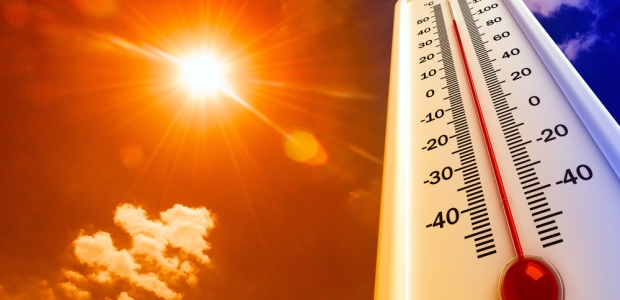
Beat the Heat!
And make sure you don't fall victim to the rest of summer's leading hazards.
- By Zachary O'Dell
- Jun 01, 2018
When summertime rolls around, it's easy to forget that even the clearest weather and sunshine can create hazards when working outdoors. If you find yourself working alone outside, you'll need to take extra precautions because any potential problems are made worse when you’re away from help.
In this list, we’ll be looking at some of the most common risks of working outdoors in the summer, and some of the ways that you can help to protect yourself.
1. Sun and Heat
Risks from sun and heat include sun stroke, dehydration, and sunburns. To avoid burning, apply sunscreen at least 30 minutes before exposure and reapply throughout the day to maintain your protection. When heat poses a danger to you, make sure that you stay hydrated, and take breaks in the shade whenever possible.
2. Poor Air Quality
During the summer, air quality can be decreased by environmental factors such as allergens, dust, and debris. It’s especially important to consider air quality if you already suffer from a respiratory condition such as asthma.
To avoid poor air quality in the summer, try to plan any trips outdoors for the coolest, driest times of the day, typically the morning or evening.
3. Extreme Weather
Just like the winter, summer has its own extreme weather conditions, including lightning strikes and tornadoes. If you're outdoors and you hear thunder, take shelter indoors or inside a car if possible. Lightning is more likely to strike tall objects, so when a structure isn’t available, it’s recommended to take shelter in low, dry areas.
To avoid lightning storms, keep an eye on the clouds and always check weather forecasts before you leave.
4. Insect Bites
For some people, severe allergic reactions can occur from insect bites, so having an EpiPen available when working outdoors is a good idea. To help you avoid mosquito and insect bites that can cause skin irritation and possibly disease, bring mosquito and insect repellents. Some repellents can cause their own irritations, so make sure to always follow the label directions before applying.
5. Irritating Plants
If you might encounter poison ivy and other irritating plants, such as poison oak, the best preventative measure is to learn to identify these plants and avoid them. If avoiding areas with these plants isn't possible, closed-toe shoes, long sleeves, pants, and gloves can all protect your skin from these plants' oils. If your clothing does come into contact with these plants, wash the clothing thoroughly to avoid second-hand reactions.
Working outdoors at any time presents new challenges and hazards, so take the time to consider the environment around you this summer. Working alone increases the danger from any environmental risk factor, so be sure that if you’re working alone this summer, you’re following good safety practices.
Preventing Heat Illnesses
OSHA warns in a chapter of its Technical Manual (available online1) that workplaces with ambient temperatures above 70 degrees Fahrenheit may have a heat hazard present when work activities are at or above a moderate workload.
Assessing workers' exposure in conditions that may present a heat hazard is critical for knowing when to implement a heat-related illness prevention programs, OSHA tells us. The document discusses NIOSH's Criteria for a Recommended Standard: Occupational Exposure to Heat and Hot Environments, a technical resource published in February 2016 that covers heat stress, symptoms of heat-related illness, and heat programs.
These illnesses include:
- Heat stroke, the most serious heat-related illness and one that should be considered a medical emergency. Heat stroke occurs when an individual’s body can't adequately dissipate heat. Core body temperature rises rapidly, the person's sweating mechanism may fail, and the body is unable to cool down. When heat stroke occurs, the body temperature can rise to 106° F or higher within 10-15 minutes.
- Heat exhaustion, a possible precursor to heat stroke, may be accompanied by elevated core body temperatures around as high as 102.2° F. Symptoms may include headache, nausea, dizziness, fatigue, weakness, thirst, heavy sweating, irritability, and decreased urine output, according to OSHA.
- Heat cramps can occur when someone's depleted salt and water levels from excessive sweating result in muscle cramps or spasms, usually in the muscles used during work.
- Heat syncope usually occurs after prolonged standing or sudden rising from a sitting or supine position; the symptoms include light-headedness, dizziness, and fainting. Dehydration and inadequate acclimatization often contribute to heat syncope, according to the OSHA document.
- Heat rash, which is skin irritation caused by excessive sweating.
The document describes the most effective way to prevent heat-related illnesses and even deaths as measures to reduce heat stress in the workplace (e.g., increase air movement, reduce temperature, reduce humidity, and protect workers from solar radiation or other radiant heat sources). These engineering controls can be useful:
- Using air conditioning
- Increasing general ventilation
- Providing cooling fans
- Running local exhaust ventilation where heat is produced
- Using reflective shields to block radiant heat
- Insulating hot surfaces (such as furnace walls)
- Stopping leaking steam
- Providing shade for outdoor work sites
Cal/OSHA conducts inspections at outdoor work sites in industries that include agriculture, construction, and landscaping during the heat season, in order to ensure employers are complying with the state’s heat illness prevention standard.
The agency reminded employers recently that they must train all employees and supervisors on heat illness prevention, provide enough fresh water so each workers can drink at least 1 quart per hour (or four 8-ounce glasses of water per hour), provide access to shade and encourage employees to cool down in the shade for at least five minutes, closely observe all employees during a heat wave and any employee newly assigned to a high-heat area, and develop and implement written procedures for complying with the standard.
Reference
1. https://www.osha.gov/dts/osta/otm/otm_iii/otm_iii_4.html